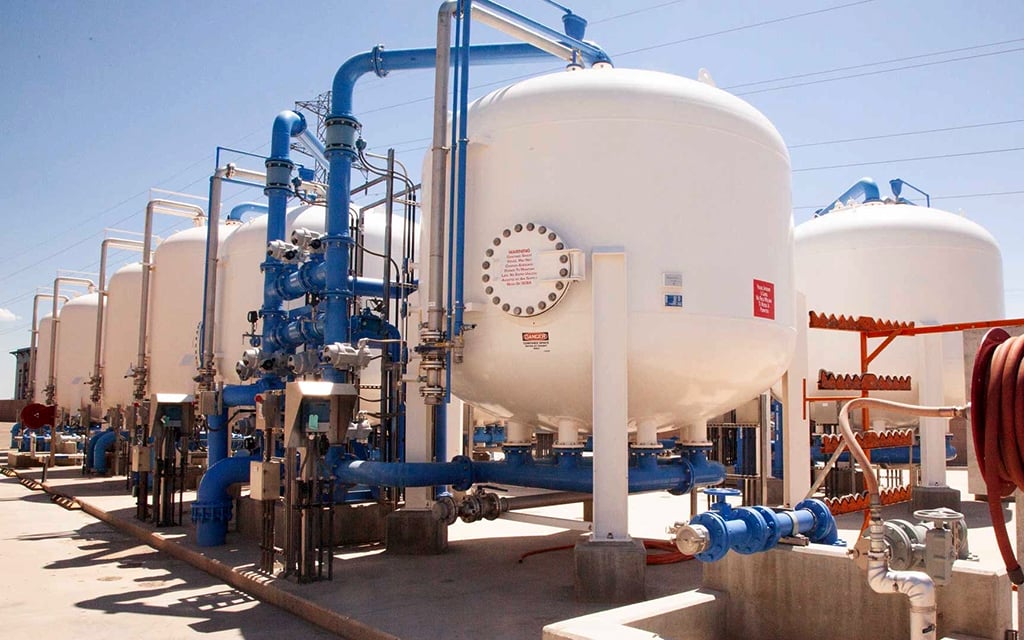
Granular-activated carbon vessels are used as part of the Tucson Airport Remediation Project, a long-term cleanup plan that aims to reduce contaminants in the groundwater. (Photo courtesy of Tucson Water)
WASHINGTON – An estimated 97% of Americans have detectable levels of invasive “forever chemicals” in their bloodstreams – many are unaware that they’re drinking them.
Per- and polyfluoroalkyl substances – or PFAS – are man-made synthetic chemicals manufactured and commercialized since the 1940s. This class of chemicals includes roughly 14,000 variations, widely used in consumer and industrial products – nonstick cookware, waterproof clothing, cosmetics and firefighter foam – due to their grease-, oil- and water-resistant properties.
At last count, water systems with levels of PFAS above Environmental Protection Agency standards are serving between 83 and 105 million people throughout the country, according to the EPA. Arizona already has eight projects underway to address this issue.
“To continue to allow Americans to be poisoned by this family of chemicals for convenience is despicable and outrageous,” said Kyla Bennett, science policy adviser at Public Employees for Environmental Responsibility.
PFAS have been linked to an increase in cancer, infertility, developmental issues and liver damage.
“We really need to turn off the tap on unnecessary PFAS use,” said Dr. Katie Pelch, senior scientist at the Natural Resources Defense Council.
The EPA released a national drinking water standard in April. The agency said the new standard will reduce PFAS exposure for nearly 100 million Americans, which in turn will “prevent thousands of deaths, and reduce tens of thousands of serious illnesses.”
This standard includes legally enforceable regulations on the maximum contaminant level allowed for six PFAS.
Under this rule, public water systems are expected to fulfill initial monitoring on contamination levels by 2027. If these levels exceed the legal standard, water systems must include solutions for PFAS reduction by 2029.
The EPA estimates that compliance with these mandates will cost roughly $1.5 billion annually.
Under the Biden administrations’ Bipartisan Infrastructure Law, $9 billion is dedicated to mitigating PFAS contamination. An additional $12 billion is available for drinking water improvements, including those targeted at chemical regulation.
The Arizona Department of Environmental Quality is in the process of testing public water systems for 29 different PFAS in hopes of fulfilling the 2027 deadline. About 950 water systems throughout Arizona will be subjected to this testing. As of April, 10% of these systems showed levels above the EPA’s max.
The ADEQ has released a statewide drinking water PFAS mitigation plan, which has motivated an early start for eight remediation projects within contaminated communities.
The town of Star Valley in Gila County announced in September a state-funded plan to mitigate contaminants.
Matthew Olson, ADEQ associate project manager, said Star Valley will construct a booster pump station that will aid the delivery of safe drinking water to three smaller water systems in the region.
The town also turned off three wells that tested positive for PFAS contamination, which Olson emphasized was a proactive approach to maintaining clean water until a more permanent solution is constructed.
The cities of Globe and Payson are using similar strategies for identifying and mitigating PFAS in their water supply.
About $30 million of Bipartisan Infrastructure Law funding has been awarded to the Tucson region – Marana, Tucson and other communities.

UV reactors are a part of the Tucson Airport Remediation Project. (Photo courtesy of Tucson Water)
Tucson Water announced the city’s share will be allocated for the construction of a second drinking water treatment facility, which aims to maintain PFAS levels below the EPA’s acceptable threshold.
John Kmiec, director of Tucson Water, said the city has been able to temporarily keep its water system PFAS free by proactively turning off wells with detectable concentrations. Despite these efforts, the Tucson aquifer is still impacted by PFAS pollution, he said.
The city’s current strategy is PFAS avoidance as it works to identify those responsible for the contamination. Both Tucson Water and the ADEQ are currently monitoring concentration levels at Tucson International Airport and Davis-Monthan Air Force Base.
Kmiec said that Tucson Water continues to share its findings with the airport, Air Force and National Guard – all parties that have been known to use Aqueous Film Forming Foam.
The foam is a fire suppressant used to fight liquid-based fires at airports, military bases, petroleum refineries, storage facilities and chemical manufacturing plants. It can have high concentrations of PFAS, and if not properly discharged can run off into surface, ground and stormwater supplies.
“We’re seeing these impacts and they really need to come support the city of Tucson,” Kmiec said. “They need to put together a strategy to stop this environmental impact so the city can protect its water supply.”
Following an inquiry by Cronkite News, the Department of the Air Force announced plans to complete PFAS contamination studies at bases near Tucson. The department said it is prepared to share costs with the city of Tucson and the Tucson Airport Authority for mitigation efforts.
The airport and Air Force did not comment after multiple requests.
The fire-fighting foam is often cited as one of the leading contributors to water contamination. The Department of Defense was required to transition to fluorine-free fire-fighting foams across their facilities and thousands of vehicles and military equipment by Oct. 1. Exemptions to the requirement are available through 2026.
Fluorine-free foam is a costly alternative to its counterpart. The Government Accountability Office estimates that foam substitutes cost about 21% more, and overall transition costs are estimated at $2 billion.
Despite the efforts that have been made to address contamination, the EPA has received criticism.
The GAO said public water systems have faced challenges when implementing PFAS treatment methods in compliance with the EPA deadlines. An estimated 77% of all systems have yet to add an effective mitigation strategy – the office said the delays are due to the agency’s inability to provide them with more straightforward information on how to safely dispose of contaminated waste.
Bennett from PEER claims that the EPA’s narrow plan is a futile attempt to address the overall PFAS issue.
Bennett said that the EPA only provides broad and differing definitions of what constitutes PFAS. Instead, she said, these chemicals should be more strictly defined and only used when absolutely necessary, such as in the production of medical devices or in tools for national security.
“It flies in the face of EPA’s only mission, which is to protect human health and the environment,” Bennett said.
